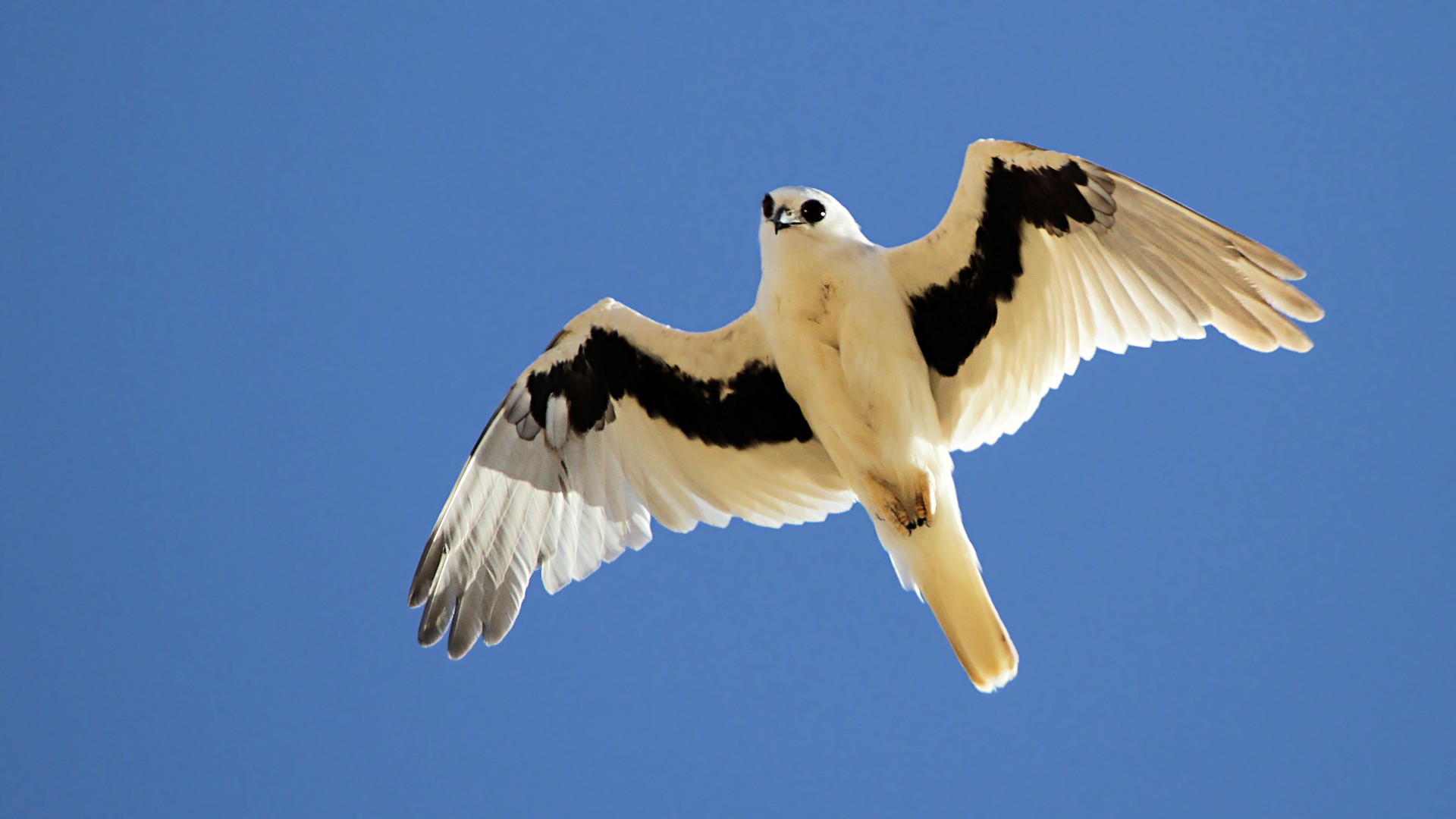| Species Details [Taxonomy: HBW - BirdLife (v3)] |
|
|
| NT |
|
Letter-winged Kite* |
Id (Atlas): |
233 |
| |
|
Elanus scriptus |
Endemic |
Description (10)

|
Letter-winged Kite
© bushpea.com
|
|
|
Medium. Nocturnal. Sexes alike.
Adults: Head, body, tail, white. Some birds have grey wash on crown and nape, or even a grey cap. Wings, grey with black shoulders. Has prominent black 'W' across whiter, partially translucent underwing. Cere, horn to black. Eye, red. Black mark in front of eye extends over but does not extend past rear of eye. Bill, black. Legs, whitish.
Immatures: Head and upperbreast, deep buff. Back and wings washed buff or brown. Bill, black. Legs, whitish.
|
Family
Accipitridae (Hawks, Eagles)
Size
34 - 38 cm
First Described (Guide)
Gould, 1842
Derivation
Ėl'-än-us - Gk, elanos, kite: scrip'-tus - L., written
Remarks
As an aid to identification in flight the following silhouettes may be of assistance


Gliding

Soaring
Abundance (Guide)
LA - UC
Usually rare but at times of rodent infestation can rapidly increase in abundance.
Habitat
Open and lightly timbered country of the arid interior.
Australia (B) (NB).
|
|
|
Centered around the Simpson Desert, the Channel country of western Queensland, and the Barkly Tableland, NT. During irruptions individuals and flocks may appear almost anywhere in eastern Australia.
|
| |
Rarity Status
View Rarity Status Information
Population
Estimated population is 1,000 - 10,000 (2010) and fluctuating.
Status NT
Threats are not known.
Secure.
For more information see BirdLife International Species Factsheet.
Habits
Usually in loose flocks, but also pairs ans singles. A largely nocturnal species, hunting at night, and tends to rest in coolabah trees during the day.
Food
Mainly Long-haired Rats during plagues, but also mice, dunnarts and other small rodents and marsupials. Usually hunts at night, roosting in trees during the day.
Voice
A harsh, rasping 'karrr'. A high, clear whistle in alarm.
 (25Kb) © ? (2) (25Kb) © ? (2)
|
Breeding Season (Guide)
Mainly July - November.
Nest
An open cup or platform composed of fine sticks, lined with leaves and fur.
Eggs (Guide)
3 - 6; matt, white to cream, spotted and blotched red-brown, concentrated at the larger end; oval to rounded-oval; about 44 x 32 mm. Incubation: 25 - 36 days; by female.
Young
Semi-altricial, nidicolous. Fledge in 30 - 35 days.
Subspecies
No subspecies.
Similar Species
Black-shouldered Kite (Elanus axillaris)
Diurnal. Adult with adult. Lacks prominent underwing black 'W' mark, having only the shoulders black. Whiter above. Black mark in front of eye extends past rear of eye. Eyes, smaller and not as red. Legs yellow.
Immatures with immatures. Overall browner with white tips to feathers. Legs yellow.
Grey Goshawk (Accipiter novaehollandiae)
Larger. Wings much wider. Underwing pure white. Grey morph: finely barred grey. Cere, bright yellow. Lacks a black mark through eye. Legs, bright yellow and longer.
Grey Falcon (Falco hypoleucos)
Greyer. Underwings white. Cere, rich yellow. Eye, black and eyering yellow. Lacks a black mark through eye. Legs, rich yellow.
Compare Images
Notes
Gregarious and mainly nocturnal.
References
See References.
The Field Guide to the Birds of Australia Pizzey, G., and Knight, E., 1997, Angus & Robertson, Sydney ISBN 0 207 19691 5
Field Guide to Australian Birds Morecombe, M., 2000, Steve Parish Publishing Pty Ltd. ISBN 1 876282 10 X
Field Guide to the Birds of Australia Simpson, K., and Day, N., 1999, 6th Edition, Viking ISBN 0 670 87918 5
Reader's Digest Complete Book of Australian Birds 1988, 2nd Edition, Reader's Digest ISBN 0 949819 99 9
What Bird is That? 1984, Revised Edition, Angus & Robertson, Sydney ISBN 0 207 14846 5
Handbook of Australian, New Zealand & Antarctic Birds 1990 - , Oxford University Press, Melbourne ISBN 0 19 553244 9
| More... see more information (images, calls, videos etc) |
Files:
 
BirdLife International
For more information about the Letter-winged Kite see...  BirdLife International Species Factsheet. BirdLife International Species Factsheet.
Articles about the Letter-winged Kite
If you would like to read any articles about the Letter-winged Kite...  Show Articles (0) Show Articles (0)
No Pictures of Letter-winged Kite
If Birdpedia has no pictures of Letter-winged Kite or you would like to see more, then try the following...
 From BING (9) From BING (9)
No Videos of Letter-winged Kite
If Birdpedia has no videos of Letter-winged Kite or you would like to see more, then try the following..
 From BING (0) From BING (0)
Where can I observe this species?
On What Field Trips was this species observed?
Latest Sightings for Letter-winged Kite
|
|